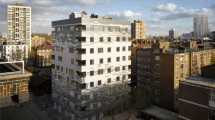Abstract
The combustion and charring properties of two types of engineered bamboo for structural applications: laminated bamboo sheets and bamboo scrimber were investigated through cone calorimeter tests conducted at three levels of heat flux, 25, 50 and 75 kW/m2. The test was conducted with the grain both perpendicular and parallel to incident heat flux. The ignitability and combustibility parameters of these two types of engineered bamboo were calculated and the time to ignition, heat release and mass loss rates, specific extinction area, effective heat of combustion, and carbon monoxide and carbon dioxide yield were compared. Based on observations for timber, the average measured charring rates from the cone calorimeter tests at a heat flux of 50 kW/m2 and exposure time of 30–60 min were taken as equivalent charring rates for standard furnace tests and compared with those promulgated by European and Australian standards. Bamboo scrimber, having a density almost twice that of laminated bamboo, demonstrated superior fire performance in all parameters considered and approached the performance of a representative hardwood. The orientation of the grain was observed to have negligible influence on their charring performance for laminated bamboo, while for bamboo scrimber, the charring rate when the grain was perpendicular to the incident heat flux was slightly smaller than when the grain was parallel to incident heat flux. Finally, this study demonstrates the utility of the relatively inexpensive cone calorimeter test, for the rapid assessment of combustion and particularly charring performance of bamboo.








Similar content being viewed by others
References
AS1720.4 (2006) Timber structures Part 4: fire resistance for structural adequacy of timber members. Standards Australia International Ltd, Sydney
ASTME119–14 (2014) Standard Test Methods for Fire Tests of Building Construction and Materials. ASTM International, West Conshohocken
Chung YJ (2010) Comparison of combustion properties of native wood species used for fire pots in Korea. J Ind Eng Chem 16:15–19
Delichatsios MA (1999) Ignition times for thermally thick and intermediate conditions in flat and cylindrical geometries. In: Curtat M (ed) Fire safety science: Proceedings of the Sixth International Symposium France. International Association for Fire Safety Science, pp 233–244
EN1995–1–2 (2004) Eurocode 5: design of timber structures—part 1–2: general—structural fire design. European committee for standardization, Brussels
Fateh T, Rogaume T, Luche J, Richard F, Jabouille F (2014) Characterization of the thermal decomposition of two kinds of plywood with a cone calorimeter—FTIR apparatus. J Anal Appl Pyrol 107:87–100
Grexa O, Lubke H (2001) Flammability parameters of wood tested on a cone calorimeter. Polym Degrad Stab 74:427–432
Hansen AS, Hovde PJ (2002) Prediction of time to flashover in the ISO 9705 room corner test based on cone calorimeter test results. Fire Mater 26:77–86
Huang D, Zhou A, Bian Y (2013) Experimental and analytical study on the nonlinear bending of parallel strand bamboo beams. Constr Build Mater 44:585–592
ISO13061–1 (2014) Physical and mechanical properties of wood–test methods for small clear wood specimens—Part 1: determination of moisture content for physical and mechanical tests. International Organization for Standardization, Geneva
ISO13061–2 (2014) Physical and mechanical properties of wood—test methods for small clear wood specimens—Part 2: determination of density for physical and mechanical tests. International Organization for Standardization, Geneva
ISO5660–1 (2002) Reaction-to-fire tests—heat release, smoke production and mass loss rate—Part 1: heat release rate (cone calorimeter method). International Organization for Standardization, Geneva
ISO834–1 (1999) Fire resistance tests—elements of building construction—Part 1: general requirements. International Organization for Standardization, Geneva
Kim J, Lee JH, Kim S (2011) Estimating the fire behavior of wood flooring using a cone calorimeter. J Therm Anal Calorim 110:677–683
Lee BH, Kim HS, Kim S, Kim HJ, Lee B, Deng Y, Feng Q, Luo J (2011) Evaluating the flammability of wood-based panels and gypsum particleboard using a cone calorimeter. Constr Build Mater 25:3044–3050
Mena J, Vera S, Correal JF, Lopez M (2012) Assessment of fire reaction and fire resistance of Guadua angustifolia kunth bamboo. Constr Build Mater 27:60–65
Sharma B, Gatóo A, Bock M, Ramage M (2015a) Engineered bamboo for structural applications. Constr Build Mater 81:66–73
Sharma B, Ramage M, Bock M, Gatoo A, Mulligan H (2015b) Engineered bamboo: state of the art. Proc Inst Civil Eng Constr Mater 168:57–67
Sinha A, Way D, Mlasko S (2014) Structural performance of glued laminated bamboo beams. J Struct Eng 140:04013021
Spearpoint MJ, Quintiere JG (2001) Predicting the piloted ignition of wood in the cone calorimeter using an integral model -effect of species, grain orientation and heat flux. Fire Saf J 36:391–415
Tsantaridis LD, Ostman BA-L (1998) Charring of protected wood studs. Fire Mater 22:55–60
White RH, Tran HC (1996) Charring rate of wood exposed to to a constant heat flux. Paper presented at the Wood Fire Safety: 3rd international scientific conference, The High Tatras
Xu Q, Chen L, Haries KA, Zhang F, Liu Q, Feng J (2015) Combustion and charring properties of five common constructional wood species from cone calorimeter tests. Constr Build Mater 96:416–427
Acknowledgments
This work was financially supported by Program of Shanghai Subject Chief Scientist (B type) (No. 15XD1522600), and the Open Fund of Shanghai Key Laboratory of Engineering Structure Safety (No. 2013-KF02).
Author information
Authors and Affiliations
Corresponding author
Rights and permissions
About this article
Cite this article
Xu, Q., Chen, L., Harries, K.A. et al. Combustion performance of engineered bamboo from cone calorimeter tests. Eur. J. Wood Prod. 75, 161–173 (2017). https://doi.org/10.1007/s00107-016-1074-6
Received:
Published:
Issue Date:
DOI: https://doi.org/10.1007/s00107-016-1074-6




